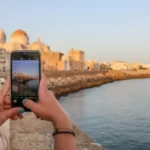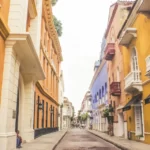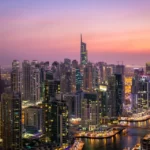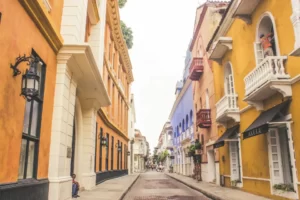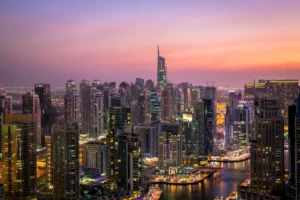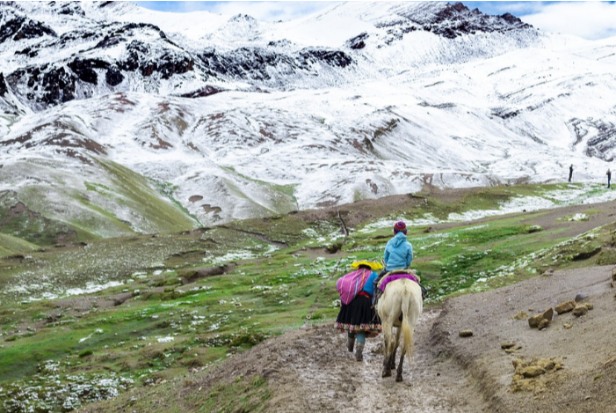
We’ll look at when is best to travel to Peru in this article. A few of Peru’s top tourist destinations and job opportunities will also be mentioned.
I sincerely hope that this guide is useful to anyone who wants to travel to this lovely and welcoming nation on the western side of South America!
The Ideal Time To Visit Peru Is When?
Wet and dry seasons alternate in Peru.
The dry season is from May to October, and the wet season is from November to April. Generally speaking, the dry season has the best weather with the smallest chance of rain. However, this will result in more expensive flights and a greater number of visitors, especially at well-known tourist destinations like Machu Picchu.
Wet season has a high chance of rain, especially in But costs are lower and there are fewer tourists in January and February. So, think about going to Peru during the wet season if you want to save money and avoid crowds at the best Peru attractions. Visit Peru in the dry season if you want to take advantage of the beautiful weather there.
So, as we have seen earlier in this article, in general terms the best time to visit Peru is the shoulder season.
However keep in mind, the best time to visit Peru for weather is anytime between May and October. The best time to travel to Peru to save money is during the rainy season, particularly January or February.
Once you’re there, Peru offers a ton of amazing places to explore. Hike well-known Andean mountains like Rainbow Mountain and Machu Picchu. Visit the Amazon Rainforest, lakes, canyons, and sand dunes. Or visit cities like Cusco, Arequipa, and Lima.
Climate In Peru
When deciding when to travel to Peru, it’s important to consider the weather patterns because altitude and various physical characteristics affect the climate differently. Every region has a unique and varied climate and environment, from the coast of the desert to the Amazon basin to the Andes.
Whereas the summer months in the Northern Hemisphere fall around June to August, the height of the summer (verano) along the desert coast more or less fits the expected image of the Southern Hemisphere. That’s to say it’s extremely hot and sunny between December and March (especially in the north), cooler and with a frequent hazy mist, known as garúa, between However, the coastal winter never gets cold enough to require a sweater anywhere other than the polluted surroundings of Lima between the months of April and November.
Lima And The Desert Coast
Temperatures in Lima range from 24 to 27 degrees Celsius between December and March, when it is most pleasant. The valley in which the city is located is covered in a light mist from June to September, but the temperature remains between 15 and 20 degrees Celsius in those months.
Although it is possible to swim year-round, you will need to wear a wetsuit because the water is cool to cold even in the best conditions due to the Humboldt Current. In the desert, it hardly ever rains, with the exception of the sporadic shower over Lima. The freak exception occurs every few years when El Niño’s change in ocean currents brings on torrential downpours that wreak havoc on communities, roads, and crops all along the coast.
Weather along the coast is more favorable in Trujillo than it is in Lima or the south. Without the dense fog that surrounds Lima or the sweltering heat of the northern deserts, it is warm and dry.
The Andes
In the Andes, the seasons are more clearly separated, with heavy rains from December to March and a warm, largely dry period from June to September. However, there will inevitably be some sunny weeks during the wet season and some rainy weeks during the dry. Pack warm clothing because the temperature changes significantly between day and night.
The Amazon Basin
In the Amazon Basin, a similar pattern prevails, but the rainier months of November to April are marked by heavier and more frequent rainfall. The entire year is also hot and muggy, with average highs of 32 °C. Confusingly, the rainy season in both the Andes and the Amazon basin is referred to locally as winter (invierno).
Places To Visit In Peru
Lima
Lima, Peru’s capital and biggest city, is found on the country’s Pacific coastline. With weather that is very different from that of the country’s center and east, the coast of Peru is thought to have a desert climate.
It rarely rains in Lima and the best times to visit are in December to April, during Summertime in Peru is the ideal time to travel if you want a beach vacation because the weather is hot and muggy. At this time of year, sunsets are also renowned for being incredibly colorful.
Due to the Humboldt Current, the water temperature in Lima is never warm but can become acceptable for swimming in the months of January, February, and March.
From May to September, Since Lima is frequently shrouded in fog and it may rain, these conditions make this a less desirable time of year to travel. But for surfers, Lima’s wintertime swells are at their highest, making this the best time to catch some waves.
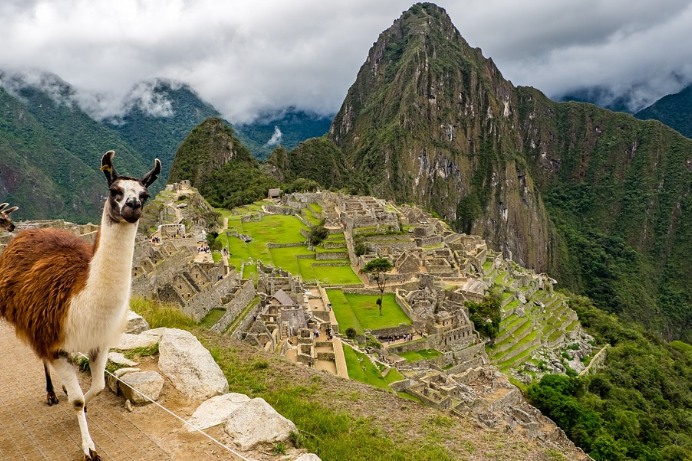
The Northern Coast
From November to March, the beaches north of The average temperature in Lima ranges from 30°C to 40°C (86-104°F), which is extremely warm. With warm weather and a respectable northern swell, the summer months are also the peak surfing season.
If you’re looking for a beach vacation, the northern portions of the coast offer warmer sea temperatures than Lima, making them better swimming locations. Mancora is one of the most popular beaches to visit on the northern coast and is most popular during the dry season. July to November, however, are considered great months for activities such as catching glimpses of humpback whales that are migrating north for calving season.
Inland, the cities of Cajamarca and Chachapoyas see the same weather conditions as the highland regions in the south, with the driest weather falling between April and November. Both are easy to visit throughout the year, although the shoulder months of April and May and September and October see pleasant weather and fewer tourists.
Festivals
Peru is a country that celebrates festivals of all sizes, from large cities to small towns and villages. These celebrations center on elaborate costumes, parades, music, dancing, and, of course, food and drink. A village fiesta, with its explosion of energy, noise, and vibrant colors, is something that happens quite frequently.
Easter, Christmas, and October are the three main national holidays, and these times are important to keep in mind if you’re considering visiting Peru during these times.
On June 24th (the winter solstice in the Southern Hemisphere), Cusco hosts Inti Rayimi (Festival of the Sun), the largest Inca celebration. One of the biggest festivals in all of South America, it features music, dance, and religious rituals and attracts tourists from all over the world.
What Month Is Ideal For Travel To Peru?
Due to regional weather variations, picking the ideal month to visit Peru can be difficult. In terms of weather, January is the best month to travel to the coast, and May to September, when it’s driest, is the best time to visit the Andes, Machu Picchu, and the Amazon.
There isn’t much point in worrying about it because you’re unlikely to discover the ideal time to visit every location in one trip. The country’s attractions are diverse enough to outweigh the requirement for assurances of favorable weather.
JANUARY
- 1st New Year’s Day. Public holiday.
FEBRUARY
- 2nd Candlemas. Folklore music and dancing are prevalent throughout Peru, but are particularly lively in Puno during the Fiesta de la Virgen de la Candelaria and in the mountainous areas.
- Carnival. While the exact date varies from year to year, Carnival is widely observed in the days leading up to Lent across the entire nation.
MARCH/APRIL
- Semana Santa (Easter/Holy Week). Excellent processions take place throughout Peru, with Cusco and Ayacucho having the best ones. The biggest ones take place on Good Friday and in the evening on Easter Saturday, a public holiday.
MAY
- 1stLabour Day. Public holiday.
- 2–3 Fiesta de la Cruz (Festival of the Cross). commemorates historical agro-astronomical rituals and the Catholic yearly calendar and is observed throughout Peru.
JUNE
- Beginning of the month Exactly nine weeks after Maundy Thursday, there is Corpus Christi, which usually takes place in the first half of June. All over Peru, it is widely observed with fascinating processions and feasts, but Cusco celebrates it in a particularly vibrant way.
- 24 Inti Raymi. Inti, the Inca god, is honored during Cusco’s principal Inca festival.
- 29 St Peter’s Day. a national holiday observed throughout the entirety of Peru, primarily with fiestas in the coastal fishing communities.
JULY
- 15–17 Virgen de Carmen. Pisac and Paucartambo both host dance and music festivals.
- 28–29 National Independence Day. military and school processions on a public holiday.
AUGUST
- 13–19th Arequipa Week. Arequipa, the second-largest city in Peru, is filled with processions, fireworks shows, lots of folk dancing, and craft markets.
- 30th Santa Rosa de Lima. Public holiday.
SEPTEMBER
- End of the month, Festival of Spring. Dance is a big part of the Trujillo festival, especially the Marinera dance and the well-known Peruvian waltzes.
OCTOBER
- 8th An official holiday is observed to remember the Battle of Angamos.
- 18–28th Lord of Miracles, a festival with opulent processions (the main ones are on October 18, 19, and 28), is celebrated. Many women don purple for the entire month, especially in Lima, where bullfights and other festivities continue all month long.
NOVEMBER
- 1st – Fiesta de Todos los Santos (All Saints Day). nationwide observance of a public holiday.
- 2nd All Souls Day, or Dia de los Muertos. A popular time for baptisms and roast pork meals, and a joyful commemoration of deceased friends and family that is observed with great reverence by the majority of Peruvians.
- 1–7th Puno Festival. One of the mainstays of Andean culture, commemorating the founding of Puno by the Spanish conquistadors as well as the founding of the Inca Empire by the legendary Manco Capac and his sister Mama Ocllo, who are said to have emerged from Lake Titicaca. A lively, colorful community dance is performed on October 5th.
- 1–30th Competitions for international bullfighting. Bullfights are held every day of the month, and the ones in Lima’s Plaza de Acho are especially spectacular.
- 12–28th Pacific Fair. One of the biggest biennial events in South America, the Av La Marina between Callao and Lima Centro hosts one of the biggest international trade fairs.
DECEMBER
- 8th The Immaculate Conception Holiday. Public holiday.
- 25th Christmas Day. Public holiday.
If you want to find more interesting and beautiful places to vise, welcome to check our best-time-visit guide below!
- Best Times to Visit Chicago – What To Prepare – On The View
- Best Time to Visit New Zealand – What To Avoid – On The View
- Best Time to Visit & Travel to Costa Rica – On The View
- Best Time to Visit Guatemala – November to April – On The View
- Best Time to Visit Panama – Everything You Should Know – On The View
- Best Time to Visit the Philippines – What You Should Avoid – On The View


